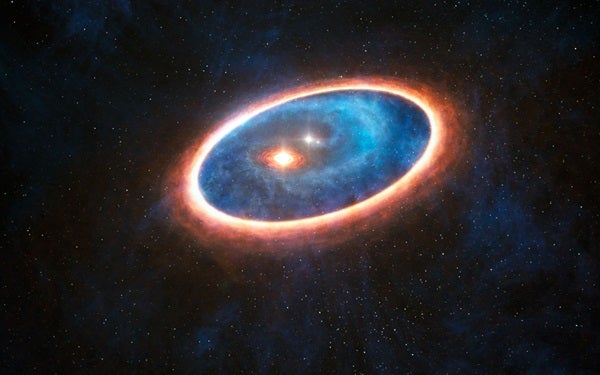A research group led by Anne Dutrey from the Laboratory of Astrophysics of Bordeaux, France, used the Atacama Large Millimeter/submillimeter Array (ALMA) to observe the distribution of dust and gas in a multiple-star system called GG Tau-A. This object is only a few million years old and lies about 450 light-years from Earth in the constellation Taurus the Bull.
Like a wheel in a wheel, GG Tau-A contains a large, outer disk encircling the entire system as well as an inner disk around the main central star. This second inner disk has a mass roughly equivalent to that of Jupiter. Its presence has been an intriguing mystery for astronomers since it is losing material to its central star at a rate that should have depleted it long ago.
While observing these structures with ALMA, the team made the exciting discovery of gas clumps in the region between the two disks. The new observations suggest that material is being transferred from the outer to the inner disk, creating a sustaining lifeline between the two.
“Material flowing through the cavity was predicted by computer simulations but has not been imaged before. Detecting these clumps indicates that material is moving between the disks, allowing one to feed off the other,” said Dutrey. “These observations demonstrate that material from the outer disk can sustain the inner disk for a long time. This has major consequences for potential planet formation.”
Planets are born from the material left over from star birth. This is a slow process, meaning that an enduring disk is a prerequisite for planet formation. If the feeding process into the inner disk now seen with ALMA occurs in other multiple-star systems, the findings introduce a vast number of new potential locations to find exoplanets in the future.
The first phase of exoplanet searches was directed at single-host stars like the Sun. More recently, it has been shown that a large fraction of giant planets orbit binary-star systems. Now, researchers have begun to take an even closer look and investigate the possibility of planets orbiting the individual stars of multiple-star systems. The new discovery supports the possible existence of such planets, giving exoplanet discoverers new happy hunting grounds.
“Almost half the Sun-like stars were born in binary systems,” said Emmanuel Di Folco from the Laboratory of Astrophysics of Bordeaux, France. “This means that we have found a mechanism to sustain planet formation that applies to a significant number of stars in the Milky Way. Our observations are a big step forward in truly understanding planet formation.”










